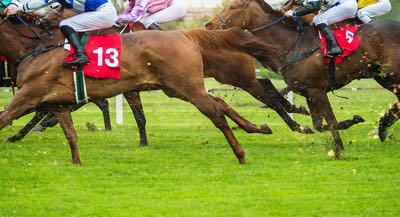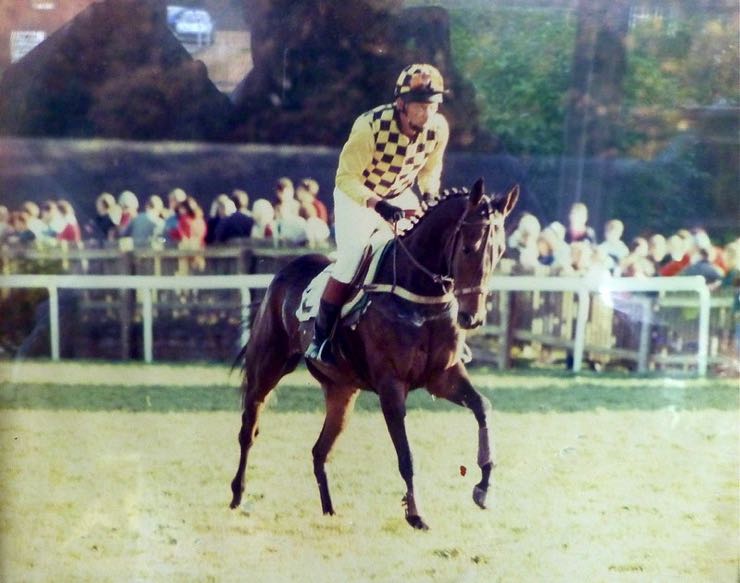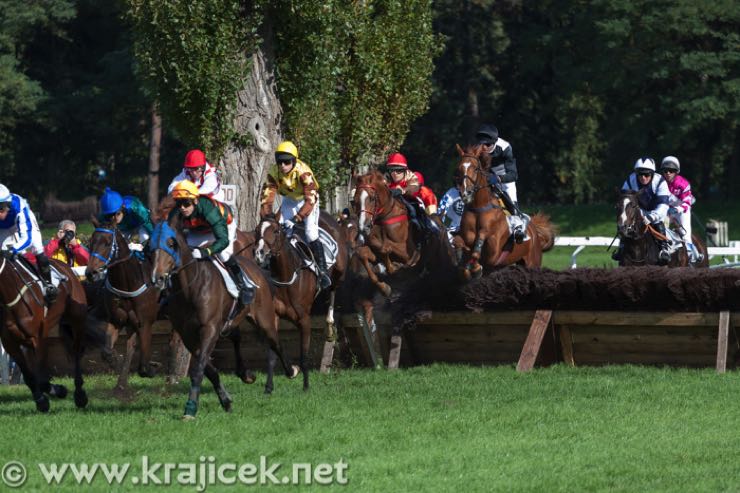 When it comes to the sport of horse racing, for many fans, it is the sight of the finest thoroughbreds in training going full throttle over the sprint distances which really sets the pulse racing. And, whilst it is hard to deny the excitement generated by these top equine athletes reaching speeds of up to 50mph, it’s not all about speed in the “Sport of Kings”. The five flat Classics all bring varying degrees of stamina into play, whilst in many of the biggest National Hunt races it is that very staying power that is very much the number one pre-requisite for success.
When it comes to the sport of horse racing, for many fans, it is the sight of the finest thoroughbreds in training going full throttle over the sprint distances which really sets the pulse racing. And, whilst it is hard to deny the excitement generated by these top equine athletes reaching speeds of up to 50mph, it’s not all about speed in the “Sport of Kings”. The five flat Classics all bring varying degrees of stamina into play, whilst in many of the biggest National Hunt races it is that very staying power that is very much the number one pre-requisite for success.
It is upon the pages of the season’s major staying contests that many of the most dramatic and enduring stories in the history of horse racing have been written; from Red Rum’s three Grand National wins, to the exploits of the likes of the brilliant Kauto Star and Denman “The Tank” in the Cheltenham Gold Cup, and many more besides. These National Hunt stars do tend to have longer careers than their flat counterparts, and it is the sight of the returning heroes attempting to conquer all once more, in these sometimes tough and gruelling contests, which lends the sport much of its enduring appeal.
Here we take a look at a selection of the longest races to be held in the world today, taking in action from the flat and National Hunt spheres in the UK and Ireland, in addition to a selection of the traditional, and more unusual, events held elsewhere in the world.
Top 10 Longest Races in the UK & Ireland

Flat racing is undoubtedly a truly global spectacle, with major Group/Grade 1 contests held annually in just about the four corners of the globe. However, the same can’t really be said of the National Hunt game, at least not to the same degree.
The UK and Ireland aren’t the only nations which stage jumps racing – far from it – but the quality of the action on offer is of a significantly higher class than that staged anywhere else in the world. The huge array and variety of jumps tracks, in tandem with massive events such as the Cheltenham Festival, the Grand National Festival at Aintree and the Punchestown Festival make the UK and Ireland the true world leaders in the sphere, and the natural stages for many of the greatest staying events on the planet.
Part of what makes the British and Irish jumps racing scene the envy of the world is the wealth of top-class staying contests on offer, many of which feature as the headline act at the season’s major festivals. We now turn to our pick of these British and Irish stamina sapping events – beginning with the most famous race of them all.
| Race | Course | Length | Grade |
|---|---|---|---|
| The Grand National | Aintree | 4m 2 1/2f | Grade 3 |
| Midlands Grand National | Uttoxeter | 4m 2f | Listed |
| Eider Chase | Newcastle | 4m 1/2f | Class 2 |
| Scottish Grand National | Ayr | 4m | Grade 3 |
| Glenfarclas Cross Country Chase | Cheltenham | 3m 7f | Class 2 |
| Welsh Grand National | Chepstow | 3m 6 1/2f | Grade 3 |
| National Hunt Chase Challenge Cup | Cheltenham | 3m 6f | Grade 2 |
| bet365 Gold Cup | Sandown Park | 3m 5 1/2f | Grade 3 |
| Irish Grand National | Fairyhouse | 3m 5f | Grade 3 |
| Queen Alexandra Stakes | Ascot | 2m 5f* | Class 2 |
* Longest flat race
Grand National (4m2½f)
The jewel in the crown of Aintree racecourse on Merseyside, and perhaps the one race on our list which really needs no introduction at all, even those who would not necessarily classify themselves as true fans of horse racing. The Grand National is Grade 3 handicap, open to runners aged seven and older, rated 120 and above, and who have previously finished placed in a chase run over a distance of three miles or more.
The Grand National remains by some distance both the most viewed, and the most bet upon event of the season – with even the virtual version held in 2020 pulling in punting and viewing figures which most “real” races would be proud of. As famous for its formidable fences, such as Becher’s Brook and the Chair, as it is for its list of legendary winners, including the recent two-time hero, Tiger Roll, the popularity of this April goliath of a race shows no signs of waning.
Midlands Grand National (4m2f)
Next in our list comes another English Grand National in the form of the Uttoxeter showpiece that is the Midlands Grand National. Nowhere near as famous, and not quite as far, as its Aintree counterpart, this Listed event held in March – for chasers aged five and older – nevertheless remains one of the highlights of the season for fans of attritional chase contests.
Held over a distance of 4m4f between 1977 and 1991, for that 14-year period this was the longest race on the British calendar, bar none. No previous winners have gone on to register a success in the Grand National itself, but both the Thinker and Synchronised did subsequently bag Cheltenham Gold Cup glory.
Eider Chase (4m½f)
We head to the North East for race number three, and one of the highlights of the jumps season at Newcastle’s dual purpose course. Held in February each year, this Class 2 event for runners aged five and above, is one of the most often abandoned of the season due to the vagaries of the weather; and when it does take place, it invariably does so in fairly treacherous conditions.
As such, whilst it may not be the longest race on the list in terms of distance, it might just be the most gruelling. Previous winners of the Eider Chase include subsequent Grand National hero Comply Or Die who did the double in 2008.
Scottish Grand National (4m)
And, moving further north still, we arrive at Ayr on the southwest coast of Scotland for the third of five “Grand Nationals” on the list. Taking place in April each year as part of the tracks two-day Scottish Grand National Meeting, this Grade 3 handicap is comfortably the biggest race of the year north of the border.
Again, open to runners aged five years and older, the four mile trip and 27 fences standing between the competitors and glory make this a test fitting of the “Grand National” moniker. Little Polvier and Earth Summit both won this race and the Aintree version during their careers, whilst the incomparable Red Rum managed to register success in both contests in the same season.
Glenfarclas Cross Country Chase (3m7f)
The midpoint of our top 10 sees the first of two events from the biggest and best jumps racing festival in the world – the magnificent four days in March that is the Cheltenham Festival. Taking place on Day 2 of the meeting at the Cheltenham Racecourse, the Glenfarclas Cross Country Chase is one of the most instantly recognisable of the festival due to the array of unusual fences and hedges the runners are required to negotiate.
Only introduced in 2005, the race hasn’t taken long to grow in prominence, thanks in no small part to the exploits of Tiger Roll who took this prior to his Grand National triumphs in both 2018 and 2019.
Welsh Grand National (3m6½f)
The festive period is one of the best times of the year to be a National Hunt fan, with a whole host of action on offer from both sides of the Irish Sea. Kempton’s King George VI Chase card on Boxing Day may take centre stage, but just one day after that comes the biggest event of the season in Wales, as Chepstow racecourse plays host to the Welsh Grand National.
In common with the other major “National’s” this is a Grade 3 handicap event, but it has thrown up a number of very high-class winners over the years, with Burrough Hill Lad, Cool Ground, Synchronised and Native River all going on to claim the Cheltenham Gold Cup. Corbiere, Earth Summit, Bindaree and Silver Birch meanwhile later added the Aintree Grand National to their CV.
National Hunt Chase Challenge Cup (3m6f)
Prior to 2020, this Cheltenham Festival Day 1 event at Cheltenham racecourse would have featured a few spots higher on this list, by virtue of being held over a trip of 4m. However, a particularly demanding edition of the race in 2019 – in which only four of the field finished – led for calls for the distance to be reduced; this was an alteration which was duly implemented ahead of the 2020 edition. A Grade 2 contest for Novice Chasers, this is the only race in the top 10 which is restricted to amateur jockeys.
bet365 Gold Cup (3m5½f)
All good things come to an end, and so it is with the National Hunt season, which officially draws to a close at the end of April. Each year, it is Sandown Park racecourse which stages a fitting send-off of a card – featuring both flat and National Hunt action – the pick of which is this Grade 3 handicap open to runners aged five and older.
Forever in the history books as the first British sporting event to receive sponsorship, thanks to the backing of Whitbread back in 1957, the bet365 Gold Cup has been won by all-time greats such as Arkle, Mill House and Desert Orchid.
Irish Grand National (3m5f)
Another contest to have been claimed by the mighty Arkle is the penultimate event in our top 10, with the legend of a racehorse shouldering 12 stone to Irish Grand National victory in 1964.
Other winners of this Grade 3 Easter Monday contest include subsequent Aintree Grand National champs Rhyme ‘n’ Reason, Bobbyjo, and Numbersixvalverde. Established way back in 1870, this Fairyhouse event is one of the most historic races on the Irish racing programme.
Queen Alexandra Stakes (2m5f)
Strictly speaking, our final race isn’t one of the 10 outright longest in the UK. It is however THE longest to be run on the flat. Two miles is generally thought to represent a staying trip on the level, with Royal Ascot’s Gold Cup a true marathon at 2m4f.
Even longer than that though is this event which also takes place at the five-day Royal Meeting in June at the Ascot racecourse. A Class 2 conditions event, the stamina requirements of the Queen Alexandra Stakes regularly see it attract runners from both the top flat and National Hunt yards.
Other Events in the UK

When we think of horse racing in the UK, we do tend to focus upon those events to be held at the many wonderful racecourses around the country, and run under the official rules of racing. There are however many other contests which take place throughout the year, and here we take a look a pair of historic events which, whilst not part of the official racing programme, do deserve a mention due to the distance over which they are held.
Kiplingcotes Derby
First up, we have the Kiplingcotes Derby. First held way back in 1519, this Yorkshire event traditionally takes place on the third Thursday in March, and is commonly believed to be the oldest annual race in Britain – if not the world.
Beginning neat the local Kiplingcotes railway station, and ending at Londesborough Wold Farm, much of the four mile “course” consists of a grassy verge by the side of the road. The race has been held every year since 1519 in all manner of conditions – even if it meant the leading of just one horse around the course. The reason for this perseverance is due to a slightly unusual rule which states that if just one edition of the race is missed, then the race must never be held again!
Newmarket Town Plate
Unlike the Kiplingcotes Derby, our second event does actually take place on a racecourse, with the round course at Newmarket having staged the Newmarket Town Plate since 1666. Won in the early years by King Charles II, the monarch stated that the race should be run “forever”, and organisers seem to be doing their best to meet that wish.
A truly amateur affair, the winners won’t appear in any official racing results books, but a distance of 3m6f, does make it one of the longest contests to be run in the land.
Top 5 Longest Races: Rest of the World

Whilst we are spoilt for choice in terms of high-class staying events in the UK and Ireland, such contests aren’t in quite such plentiful supply elsewhere in the world. They do certainly exist though, with Australia, Belgium, the Czech Republic, France, Italy, Japan, New Zealand and the USA amongst those nations who all stage popular jumps racing.
Racing fans in the UK will likely have at least a passing familiarity with our top 10 longest races from these shores, but we now take a look at the longest races from five other racing jurisdictions around the world. Top marks if you can name a recent winner of any of the following five events!
Czech Republic: Velká Pardubická (4m2½f)
We begin with a race which ties with our very own Aintree Grand National as the longest to be run anywhere in the world – at least under the standard rules of racing. Featuring all manner of fences, hedges, walls, banks and water jumps amongst the 31 obstacles to be negotiated, there are many who view the Velká Pardubická as being the world’s toughest staying contest.
First run way back in 1874, the race is traditionally held on the second Sunday in October, and perhaps has the most in common with the Glenfarclas Cross Country Chase of those races to be held in the UK.
France: Grand Steeple-Chase de Paris (3m6f)
It seems 1874 was a good year for staying chase events, as also making its debut in that year was the longest race on the French racing calendar: the Grand Steeple-Chase de Paris.
Held at Auteuil in May each year, this top class Grade 1 affair is the richest jumps race of the French season – total prize money of £700,000 in 2019 – and regularly attracts the cream of the home team, in addition to challengers from further afield.
Australia: Grand Annual (3m3f)
For many European fans, their knowledge of Australian horse racing may begin and end with the Melbourne Cup. There’s plenty more going on Down Under though, and not just on the flat. The pick of the jumping action comes at Warrnambool racecourse in Victoria during the track’s May racing carnival.
At 3m3f, the Grand Annual may be some way off the longest race in the world, but it does have the distinction of having more obstacles than any other steeplechase, with a total of 33 to be safely negotiated.
Italy: Gran Premio Merano (3m1f)
We head back to Europe for the final two entries on our list. Taking place at Pferderennplatz Meran racecourse in the picturesque spa town of Meran in the North of Italy, this contest favours unusual cross-country style obstacles, with the addition of some truly towering hedges.
Taking place in September, the list of winning horses likely won’t be too familiar to British racing fans, but a couple of the winning riders might be, with James Reveley and Jim Crowley both featuring on the roll of honour.
Belgium: Grand Steeple-Chase des Flandres (2m7f)
There are a number of international “Grand Nationals” which take place around the world, with the US race over 2m6f narrowly missing out on the top five, in favour of the slightly longer Belgian version, which takes place at Waregem racecourse in August.
Including banks jumps, hedges and a famous obstacle featuring a small section of the Gaverbeek River, this is by some distance the biggest race of the Belgian season. Whilst not the highest profile of the European jump races by any means, the race does still attract the occasional overseas raider, with British-trained runners filling fourth and fifth spot in 2019.
Endurance Racing

The focus of this article has been upon those marathon contests to be held under the traditional rules of racing. However, if we are to widen the criteria to include ANY horse race to be held on the planet, then the races on our lists – even the Grand National itself – would be mere sprints in comparison to those taking place in the world of endurance racing.
California, USA: The Tevis Cup
A relatively popular minor sport in the USA, backed by its own organising and sanctioning body, and commonly known as Trail Racing, this most arduous of disciplines sees runners and riders tackling trips of up to 100 miles in a single day.
The sport’s signature event of The Tevis Cup takes place in California each year, with the treacherous rocky terrain of the Sierra Nevada adding to the test. The cup is then awarded on a combined basis of completing the course in the fastest time, and the wellbeing of the horse at the culmination of the race.
Mongolia: The Mongol Derby
Even the Tevis Cup has nothing on the longest recorded race on the planet though. That honour belongs to The Mongol Derby. Inaugurated in 2009 and taking place in Inner Mongolia, the race is designed to replicate the horse-based postal system used in the era of Genghis Khan.
Held over a staggering distance of 1000km (671 miles), the event takes around 10 days to complete, with riders expecting to be in the saddle for around 13 hours per day. Clearly, it would be unfair to ask a solitary horse to complete such a journey, and riders duly change their mounts around 25 times during the contest. With a course featuring mountainous terrain, floodplains, sand dunes and more, it makes the Grand National look like a walk in the park!